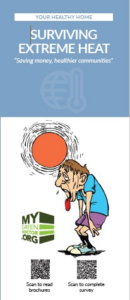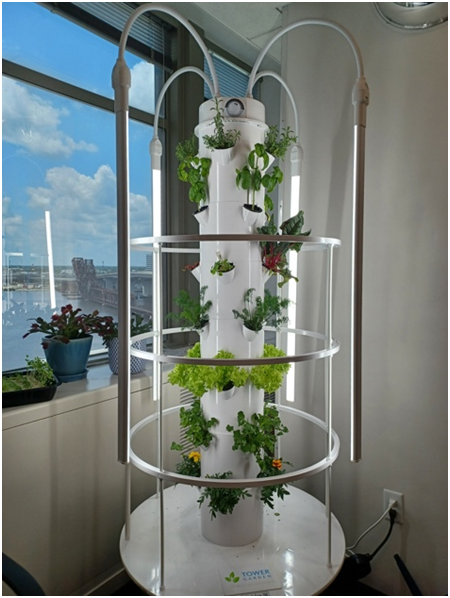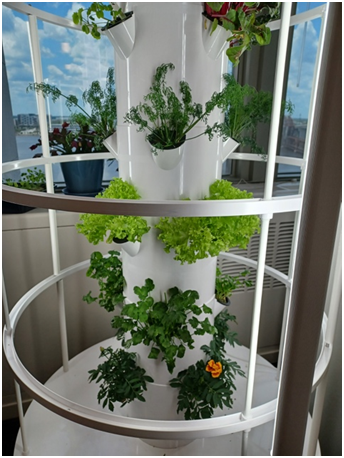Meeting-by-Meeting Guide
Meeting-by-Meeting Guide
This Meeting-by-Meeting Guide makes it easy to add five minutes of My Green Doctor business once a month to the agenda of a healthcare practice’s regular organizational meetings. Some practices put five minutes of MGD onto each monthly staff meeting agenda; others make it part of their morning team huddle once a month. The Meeting-by-Meeting Guide provides a script for each five-minute session so there is nothing for the office manager or other leader to study or prepare.

We recommend doing this every month but ONLY once a month. Your practice is already very busy with the responsibilities of providing great medical care. Too often practices try to “go green” too quickly and the pace becomes unsustainable. Plan to have five minutes of My Green Doctor on every monthly staff meeting agenda but just five minutes and only monthly.
Each month, read aloud the Meeting-by-Meetings script at your staff meeting or print out the page for the current meeting and take it with you to the meeting. Your practice will discuss the script and make small practice management decisions each month, decisions that add up over time to big savings of money and resources. And your practice can qualify for the Green Practice Recognition Certificate after just five meetings. This is also how clinicians and practice managers help address global climate change.
After your tenth meeting, your practice’s environmental sustainability program will continue by using My Green Doctor’s seven Workbooks (https://mygreendoctor.org/workbook-1-introduction/ ). There you will find more than 140 Action Steps and Education Steps.
Scroll down to read the Meeting-by-Meeting Guide for each month, or click below to access the PDF version for the month you are working on.
And before your first MGD session at your staff meeting:
- Watch our Three Minute Video that explains how to use My Green Doctor to add environmental sustainability to your practice: https://www.youtube.com/watch?v=3fnbG5SNAUQ.
- Get Support from The Office: It is important that your office leadership is committed to having an environmental sustainability program. Speak with your manager, chief executive, owner, or partner.
- Add “My Green Doctor” to Your Agendas: It is easy to add five minutes of My Green Doctor once a month to the agenda of your regular staff meetings.
- Find A Leader:Identify a person to lead each five-minute My Green Doctor agenda.
- Record “Green Meeting Notes”: After each meeting, your leader will record your progress using the Green Meeting Notes Form: https://mygreendoctor.org/green-meeting-notes-form/. In addition, we provide here a one-page spread sheet to see in one place all the Meeting-by-Meeting topics and keep track of your accomplishments and plans: Accomplishments Spreadsheet
- Plan for success: Commit to qualifying for the Green Practice Recognition Certificate within six to none months.
Meeting-by-Meeting Schedule
(scroll down for each month’s script or read the PDF for each meeting)
Meeting 1: Welcome to Environmental Sustainability
Meeting 2: Begin “Workbook 1: Energy Efficiency”
Meeting 3: Continue with “Workbook 1: Energy Efficiency”
Meeting 4: Begin “Workbook 4: Solid Waste & Recycling”
Meeting 5: Continue “Workbook 4: Solid Waste & Recycling”
Meeting 6: Patient Education
Meeting 7: Begin “Workbook 5: Drug Disposal & Chemicals”
Meeting 8: Continue “Workbook 5: Drug Disposal & Chemicals”
Meeting 9: Begin “Workbook 7: Healthy Foods”
Meeting 10: Assessment and Looking Forward
Continuing Meetings: “The Road Ahead is Green”
After ten monthly meetings, practices use My Green Doctor’s seven Workbooks to find further Actions Steps. Your practice will continue to include five minutes of My Green Doctor on every monthly staff meeting agenda. At each these meetings, review the status of the Action Steps that you have already taken. For example, ask “how are we doing with our recycling program?” or “what is the status of our energy-saving decisions?” If there is time, choose a new Action Step or Education Step from the Workbooks. We can help: make an appointment with My Green Doctor consultants to help guide your next directions: [email protected] .
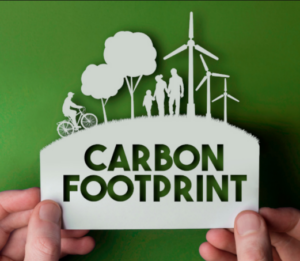
Scripts for Monthly Meetings 1 - 10

Meeting 1: Welcome to Our Environmental Sustainability Program
- Announce that environmental sustainability is a new practice activity that will be on the agenda of a meeting once a month. Announce who will be the initial leader for these discussions.
- Explain that this will take about five minutes once a month during the meetings.
- Explain the My Green Doctor website will be the guide for the environmental sustainability program. Encourage each person to register at www.MyGreenDoctor.org. It takes three minutes to register. Provide your discount code if your practice has one.
- Explain that your office or clinic will use My Green Doctor to make gradual improvements in the office. The topics will include energy efficiency, water use, recycling, climate change, renewable energy, transportation choices, healthy foods, and patient education.
- Read aloud “Ten Reasons to Go Green”: https://mygreendoctor.org/welcome-to-my-green-doctor/ten-reasons-to-go-green/
- Find someone to print two copies of your Pledge Certificate and to buy simple frames for displaying these in your waiting room and staff break room.
- After the meeting, fill out the Green Meeting Notes form. Keep it very brief– not more than 5 minutes for completing the form: Green Meeting Notes Form . File this and email it to [email protected].
Ten Reasons to “Go Green”
- Leads to wiser & more responsible uses of resources.
- “Going Green” saves money by lowering office expenses.
- Creates a healthier work environment.
- Encourages teamwork and finding better ways to do things.
- Can generate ideas from every member of the office or clinic.
- Improves job satisfaction.
- Enhances the office’s public image and the trust of patients.
- Decreases air pollution, water consumption, and waste.
- Builds a healthier community.
- Helps to make environmental sustainability part of everyone’s life!
Meeting 2: Begin Workbook 1: Energy Efficiency
- Thank everyone for participating in our environmental sustainability program.
- Remind everyone that your office or clinic includes five minutes of environmental sustainability in the staff meeting once a month.
- At this meeting, we will choose TWO Action Steps from the “Quick Start, Now!” section of “Workbook 1: Energy Efficiency”. https://mygreendoctor.org/workbook-1-introduction/. These steps are provided below.
- Announce that at the next meeting, you will continue with “Energy Efficiency”.
- After the meeting, fill out the Green Meeting Notes form. Keep it very brief– not more than 5 minutes for completing the form: Green Meeting Notes Form . File this and email it to [email protected].
 Consider using telehealth appointments, if possible, depending on patient need, to reduce patient transportation time, cost, and pollution from travel to your office.
Consider using telehealth appointments, if possible, depending on patient need, to reduce patient transportation time, cost, and pollution from travel to your office.
 Energy Action Steps
Energy Action Steps
 Turn Machines Off
Turn Machines Off
Adopt a policy to turn off lights, computers, monitors, fax machines, copiers, and printers at night. This saves a lot of energy and money. Set computer monitors to “sleep mode” if they must stay on. Perhaps plug all machines into power strips to make it easy to turn them off at night with just one button. You might tape reminder messages onto machines to “Please turn me off!” Speak with your janitorial staff who might be leaving the lights on at night and ask them to please turn off the lights when they are finished working.
Issues to discuss:
- Can we agree to do this?
- Do a quick mental inventory of your machines and lights. Are there some that must stay on?
- Who will be the leader for this Action Step and report back at the next meeting?
 Monitor Your Electricity and Gas Bills
Monitor Your Electricity and Gas Bills
Does your office receive monthly energy bills? If you are in a large building, you may not
receive a separate bill for the energy that you use. If you do get monthly bills, ask one person to gather your bills for the past year, and to report your future energy savings every 2-3 months. Your utility company’’s website likely can tell you how to calculate how much carbon dioxide you are reducing – the main greenhouse gas that causes climate change.
Issues to discuss:
- Can we agree to do this?
- Who will be the leader for this Action Step & report back in 2-3 months?
 Replace Lightbulbs: Choose Compact Fluorescent Bulbs (CFB) or Low Emitting Diode (LED) Bulbs
Replace Lightbulbs: Choose Compact Fluorescent Bulbs (CFB) or Low Emitting Diode (LED) Bulbs
Change all incandescent lights (those with filaments inside) to Compact Fluorescent Bulbs (CFBs) or to Low Emitting Diode (LED) bulbs. LEDs are preferred because they use so very little electricity. A75 watt incandescent bulb is replaced with a 25W CFB.
Most fluorescent bulbs contain mercury, a potent neurotoxin. The typical CFB contains 5mg, compared with 100mg in a mercury thermometer. Most large hardware stores accept used fluorescent bulbs and will dispose of the mercury safely. You also can call your trash collector or local government to find out how to dispose of used fluorescent bulbs in your area.
Also, the following links contain additional recycling information:
Recycling Simplified in the U.S.
Waste Management Recycling Tips
Issues to discuss:
- Can we agree to do this?
- Do we have dimmer switches that don’t allow bulb types to be changed?
- Do we have a plan to discard used bulbs properly?
- Who will be the leader for this Action Step and report back at the next meeting?
 Add Motion Sensors to Light Switches
Add Motion Sensors to Light Switches
Adding a motion sensor to a light switch in each room will minimize the amount of electricity your practice uses by automatically sensing when there is no one in the room and turning off the lights accordingly.
Issues to discuss:
- Can we agree to do this?
- Who will take the lead to contact the building manager or electrician to have this completed?
 Thermostat Policy
Thermostat Policy
Adopt an office policy to set thermostats to 74 degrees F (23 C) in the summer and 68 degrees F (20 C) in the winter. Put reminder stickers on the thermostats for these settings. Allow and encourage staff members to wear clothing that is comfortable when working with these thermostat settings (lighter weight cotton and linen items in warm weather and layers like cardigans or sweaters in cold weather). Did you know that most office temperatures are set by men and are uncomfortably cold for the women who work there?
Issues to discuss:
- Can we agree to do this?
- Do we need to coordinate this with the building manager?
- Who will be the leader for this Action Step and report back at the next meeting?
 Turn Off Your Hot Water Heater
Turn Off Your Hot Water Heater
Most doctor offices can turn off their hot water heaters, without health consequences. Handwashing requires soap, water, and friction, but not heat. A large public health clinic in Pensacola, Florida studied this option, found it to be safe, and is saving hundreds of dollars annually. If you cannot turn off the heater itself, close the hot water valve under sinks so that hot water is not used.
If your practice cannot turn your hot water heater off, adjust the heater so the “hot” temperature is not so hot. Try turning down your water heater temperature to an energy-efficient 120 F or 48 C.
Issues to Discuss:
- Can we agree to do this?
- Who will be the leader for this Action Step?


Meeting 3: Continue with Workbook 1: Energy Efficiency
- Thank everyone for participating.
- Remind everyone that your office or clinic includes five minutes of environmental sustainability in the staff meeting once a month.
- At this meeting, review your progress with the two Action Steps that were adopted at Meeting 2. Adopt one or two more Steps from our “Quick Start, Now!” section of “Workbook 1: Energy Efficiency”. https://mygreendoctor.org/workbook-1-introduction/. These are provided below.
- Announce that at the next meeting, you will begin the topic of Solid Waste & Recycling.
- After the meeting, fill out the Green Meeting Notes form. Keep it very brief– not more than 5 minutes for completing the form: Green Meeting Notes Form . File this and email it to [email protected].
 Energy Action Steps
Energy Action Steps
 Turn Machines Off
Turn Machines Off
Adopt a policy to turn off lights, computers, monitors, fax machines, copiers, and printers at night. This saves a lot of energy and money. Set computer monitors to “sleep mode” if they must stay on. Perhaps plug all machines into power strips to make it easy to turn them off at night with just one button. You might tape reminder messages onto machines to “Please turn me off!” Speak with your janitorial staff who might be leaving the lights on at night and ask them to please turn off the lights when they are finished working.
Issues to discuss:
- Can we agree to do this?
- Do a quick mental inventory of your machines and lights. Are there some that must stay on?
- Who will be the leader for this Action Step and report back at the next meeting?
 Monitor Your Electricity and Gas Bills
Monitor Your Electricity and Gas Bills
Does your office receive monthly energy bills? If you are in a large building, you may not
receive a separate bill for the energy that you use. If you do get monthly bills, ask one person to gather your bills for the past year, and to report your future energy savings every 2-3 months. Your utility company’’s website likely can tell you how to calculate how much carbon dioxide you are reducing – the main greenhouse gas that causes climate change.
Issues to discuss:
- Can we agree to do this?
- Who will be the leader for this Action Step & report back in 2-3 months?
 Replace Lightbulbs: Choose Compact Fluorescent Bulbs (CFB) or Low Emitting Diode (LED) Bulbs
Replace Lightbulbs: Choose Compact Fluorescent Bulbs (CFB) or Low Emitting Diode (LED) Bulbs
Change all incandescent lights (those with filaments inside) to Compact Fluorescent Bulbs (CFBs) or to Low Emitting Diode (LED) bulbs. LEDs are preferred because they use so very little electricity. A75 watt incandescent bulb is replaced with a 25W CFB.
Most fluorescent bulbs contain mercury, a potent neurotoxin. The typical CFB contains 5mg, compared with 100mg in a mercury thermometer. Most large hardware stores accept used fluorescent bulbs and will dispose of the mercury safely. You also can call your trash collector or local government to find out how to dispose of used fluorescent bulbs in your area.
Also, the following links contain additional recycling information:
Recycling Simplified in the U.S.
Waste Management Recycling Tips
Issues to discuss:
- Can we agree to do this?
- Do we have dimmer switches that don’t allow bulb types to be changed?
- Do we have a plan to discard used bulbs properly?
- Who will be the leader for this Action Step and report back at the next meeting?
 Add Motion Sensors to Light Switches
Add Motion Sensors to Light Switches
Adding a motion sensor to a light switch in each room will minimize the amount of electricity your practice uses by automatically sensing when there is no one in the room and turning off the lights accordingly.
Issues to discuss:
- Can we agree to do this?
- Who will take the lead to contact the building manager or electrician to have this completed?
 Thermostat Policy
Thermostat Policy
Adopt an office policy to set thermostats to 74 degrees F (23 C) in the summer and 68 degrees F (20 C) in the winter. Put reminder stickers on the thermostats for these settings. Allow and encourage staff members to wear clothing that is comfortable when working with these thermostat settings (lighter weight cotton and linen items in warm weather and layers like cardigans or sweaters in cold weather). Did you know that most office temperatures are set by men and are uncomfortably cold for the women who work there?
Issues to discuss:
- Can we agree to do this?
- Do we need to coordinate this with the building manager?
- Who will be the leader for this Action Step and report back at the next meeting?
 Turn Off Your Hot Water Heater
Turn Off Your Hot Water Heater
Most doctor offices can turn off their hot water heaters, without health consequences. Handwashing requires soap, water, and friction, but not heat. A large public health clinic in Pensacola, Florida studied this option, found it to be safe, and is saving hundreds of dollars annually. If you cannot turn off the heater itself, close the hot water valve under sinks so that hot water is not used.
If your practice cannot turn your hot water heater off, adjust the heater so the “hot” temperature is not so hot. Try turning down your water heater temperature to an energy-efficient 120 F or 48 C.
Issues to Discuss:
- Can we agree to do this?
- Who will be the leader for this Action Step?
 Consider using telehealth appointments, if possible, depending on patient need, to reduce patient transportation time, cost, and pollution from travel to your office.
Consider using telehealth appointments, if possible, depending on patient need, to reduce patient transportation time, cost, and pollution from travel to your office.
Meeting 4: Begin Workbook 4 Solid Waste and Recycling
- Thank everyone for participating in our environmental sustainability program.
- Remind everyone that your office or clinic includes five minutes of environmental sustainability in the staff meeting once a month.
- Ask your leaders to report on the progress with the Energy Efficiency Action Steps.
- At this meeting, we will discuss how to minimize and recycle our office waste. Read aloud the “Recycling Your Waste” Action Step from Workbook 4 (provided below). https://mygreendoctor.org/workbook-4-solid-waste-recycling/
- Announce that at the next meeting, we will continue with Solid Waste and Recycling.
- After the meeting, fill out the Green Meeting Notes form. Keep it very brief– not more than 5 minutes for completing the form: Green Meeting Notes Form . File this and email it to [email protected].
 Solid Waste and Recycling Action Steps
Solid Waste and Recycling Action Steps
 Recycling Your Waste
Recycling Your Waste
Agree to a goal of recycling for your office waste. Learn what materials can be recycled by commercial buildings in your town. Certainly, you can recycle newspapers, plastic bottles, glass bottles, and aluminum. What about food waste or Styrofoam?
Recycling can be complex and may need a committee of 2-4 people to take responsibility for this Action Step. If your office space is not owned by your practice, ask the building manager whether recycling is available for the building tenants. If the building does not offer recycling, volunteers from the office may need to bring the recycling materials home to be recycled.
For general recycling advice try:
– Recycling Simplified in the U.S.
– Waste Management Recycling Tips
Post a checklist or a sign that the following items can be recycled: Paper, Newspapers, Magazines, Plastic Bottles, Glass Jars and Bottles, Aluminum Cans
There are three main companies in the U.S. that handle most recycling for commercial buildings. The biggest company is Waste Management. If commercial recycling isn’t available through Waste Management, you can also contact CBRE and JLL (other large recycling companies) to see if they provide service to your practice’s local area. Here are the links to these companies:
–CBRE
–JLL
The Waste Management company also offers pre-made recycling kits to help your office recycle a variety of items: Waste Management Recycle Kits
Issues to discuss:
- Can we agree to do this?
- Will the trash collector accept these or will a staff member volunteer to take home our recycled materials?
- What recycling bins are needed for each office room and for the waiting room?
- Who will purchase recycling bins?
- Who will monitor the bins weekly, and record how many bins, or bags of materials we recycle each week?
- Who will talk with the cleaning personnel to be sure that our recyclable materials are not discarded as common trash?
 Recycle Your Used Batteries
Recycle Your Used Batteries
Adopt a policy to recycle used batteries. The Waste Management company offers on their website (United States only) a Dry Cell Battery Recycling Kit for $24.95 that comes with free shipping to return the batteries for recycling. Here is a link to the kit: Recycle Used Batteries
Issues to Discuss:
- Can we agree to do this?
- Who will be the leader for this Action Step?
 Adopt a Policy for Safe Disposal and Recycling of Fluorescent Light Bulbs
Adopt a Policy for Safe Disposal and Recycling of Fluorescent Light Bulbs
Adopt a policy to safely dispose of and/or recycle used fluorescent light bulbs. Waste Management offers two lightbulb recycling kits on their website (for practices in the United States). Here is the link to the kits: Recycle Fluorescent Bulbs
Issues to Discuss:
- Can we agree to do this?
- Who will be the leader for this Action Step?
 Adopt a Policy to Recycle or Refill Printer Ink Cartridges
Adopt a Policy to Recycle or Refill Printer Ink Cartridges
Printer ink cartridges can be recycled by taking them to Staples, Best Buy, or Office Max/Office Depot and dropping them off. Call first to confirm that your local store has this program. Also, if your medical practice uses HP cartridges, send them back to HP. They have a closed loop recycling program, and they will recycle or repurpose your items. Here is the link to the recycling program for HP: HP Recycling
Issues to Discuss:
- Can we agree to do this?
- Who will be the leader for this Action Step?
 Consider not using paper on the exam room table.
Consider not using paper on the exam room table.
This can help reduce waste if you are also cleaning your exam room table with disinfectant.
Issues to Consider:
- Can we agree to do this?
- Who will agree to lead this topic?
 Consider whether a patient can be examined wearing their own clothing.
Consider whether a patient can be examined wearing their own clothing.
If a patient gown is needed, consider using washable, reusable patient gowns that are laundered and delivered in recyclable/de-compostable packaging.
Issues to Consider:
- Can we agree to do this?
- Who will agree to lead this topic?
 Consider composting items from your office and breakroom/kitchen.
Consider composting items from your office and breakroom/kitchen.
Many areas have companies that will collect your compostable items, provide compostable containers, etc. Try searching “Are there any companies that collect compostable materials near me?” in your web browser for more information about composting in your area.
Issues to Consider:
- Can we agree to do this?
- Who will agree to lead this topic?
 Consider talking to your vendors about options for purchasing surgical trays that only contain the items that are used during surgeries to reduce single use plastic waste.
Consider talking to your vendors about options for purchasing surgical trays that only contain the items that are used during surgeries to reduce single use plastic waste.
Also consider asking vendors to reduce the size of the packaging for items, as well as change the packaging to something that is recyclable or compostable.
Issues to Consider:
- Can we agree to do this?
- Who will agree to lead this topic?

Meeting 5: Continue “Workbook 4: Solid Waste & Recycling”
- Thank everyone for participating in our environmental sustainability program.
- Remind everyone that your office or clinic includes five minutes of environmental sustainability in the staff meeting once a month.
- Ask your leaders to report on the progress so far with the Energy Efficiency and Solid Waste & Recycling Action Steps.
- At this meeting, we will discuss how to minimize and recycle our office waste. Read aloud the “Recycling Your Waste” Action Step from Workbook 4 (provided below). https://mygreendoctor.org/workbook-4-solid-waste-recycling/
- Announce that at the next meeting, we will focus on the topic of Education for the staff and patients.
- After the meeting, fill out the Green Meeting Notes form. Keep it very brief– not more than 5 minutes for completing the form: Green Meeting Notes Form . File this and email it to [email protected].
 More Solid Waste and Recycling Action Steps
More Solid Waste and Recycling Action Steps
 Buy Recycled Paper
Buy Recycled Paper
Adopt a policy to buy only recycled-content and low toxicity paper products. Paper comes with different amounts of recycled content; your office supply vendor will explain the options. Set a goal of at least 30% recycled content. Recycled paper costs a bit more but your energy savings from Meetings 2 and 3 may more than pay for it. Consider using only recycled paper and only vegetable dye inks for outside printing orders. Recycled paper is available for purchase for every paper product in the office: patient gowns, exam table covers, notepads, stationery, patient handouts, charts, photocopy and printer paper, brochures, business cards, etc.
Issues to discuss:
- Can we agree to do this? Which paper products shall we buy with recycled content?
- Who will agree to lead this topic?
- Can we develop a schedule for transitioning to recycled paper products?
 Recycle or Refill Printer Ink Cartridges
Recycle or Refill Printer Ink Cartridges
Printer ink cartridges can be recycled by taking them to Staples, Best Buy, or Office Max/Office Depot and dropping them off. Call first to confirm that your local store has this program. Also, if your medical practice uses HP cartridges, send them back to HP. They have a closed loop recycling program, and they will recycle or repurpose your items. Here is the link to the recycling program for HP: HP Recycling . Here’s another tip: in the US and Canada, EnvironmentFirstPrinting.com offers soy based ink (no fossil fuels used) for every commercial printer type, and also recycles the printer cartridges. Using this ink does not invalidate printer warranties but check with your maker.
Issues to discuss:
- Can we agree to do this?
- Where will we collect our used printer cartridges to recycle them?
- Who will lead this Action Step?
 Say “No” to Styrofoam
Say “No” to Styrofoam
Agree as an office not to use Styrofoam or similar disposable cups and plates. Styrofoam is made with environmentally unfriendly manufacturing methods and is wasteful. Speak with your product vendors about cups and plates made from alternatives such as paper, soy, or corn. Other steps to consider include:
- Buy sets of inexpensive dishes for the office.
- Decide not to offer straws in the office.
- Encourage office colleagues to bring their own reusable cups for water, tea, and coffee.
- Inform the salespeople who bring food & beverages to your office that you no longer accept Styrofoam.
- Tell your patients that “this office no longer uses Styrofoam”.
Issues to discuss:
- Can we agree to do this?
- Can we order paper or corn-based cups, flatware, and straws, or purchase inexpensive reuseable cups, plates, and silverware for the office that can be washed?
- Can we re-use our personal cups and glasses?
- How can we inform our colleagues, patients, and families about this?
- Who will lead this Action Step?
 Eliminate Bottled Water and the Water Cooler
Eliminate Bottled Water and the Water Cooler
Eliminating bottled water and the water cooler saves money, saves electricity, and avoids a lot of plastic waste. Of course, you can only do this if your town’s public water supply is safe to drink.
Bottled water is expensive, wasteful, and less rigorously tested for safety than most public water supplies. Encourage your employees to bring reusable water bottles to the office.
Another way to reduce single-use plastic bottled water is to install a refillable water bottle fountain or station. Some examples of refillable water bottle fountains are:
Issues to discuss:
- Can we agree to do this?
- Who will lead this Action Step?
- Can we print for the waiting room the My Green Doctor brochure, “Choose Tap Water”? https://mygreendoctor.org/resources/waiting-room-brochures/
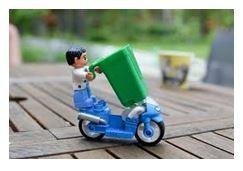

Meeting 6: Education: Information for Patients & Families
For Meeting 6, bring a computer for this meeting and open it to the page: https://mygreendoctor.org/tip-of-the-month/.
1. Thank everyone for participating. Explain that the Meeting 6 is about informing patients and families on wise environmental sustainability and climate change choices that can save them money and improve their health.
2. Ask your leaders to report on the progress with your Energy Efficiency and Solid Waste & Recycling Action Steps
3. Choose one or two Education Steps for the practice from the list below.
4. Announce the date for the next meeting, on the topic,” Drug Disposal & Chemicals”.
5. After the meeting, fill out the Green Meeting Notes form. Keep it very brief– not more
than 5 minutes for completing the form: Green Meeting Notes Form . File this and email it to [email protected].
 Education Steps
Education Steps
 Education Step: Provide a Handout That Gives Patients Access to My Green Doctor’s Brochures
Education Step: Provide a Handout That Gives Patients Access to My Green Doctor’s Brochures
My Green Doctor’s Healthy Home brochures are packed with easy-to-understand background information and with ideas for the home. Using the QR code below, the brochures can be read using a smart phone or computer with no special software needed. Create a one-page handout to leave for patients in the waiting room or to give to them at discharge. It might say: “We wish to share ideas for your home and family about environmental sustainability and climate change. This information may save you money and improve your health. Use this QR code to read practical brochures on your computer or phone, available on many topics and in English and Spanish languages:
You might include some of these images on the handout:
Print One or More Patient Brochure
From the Education page, decide to print one or more brochures to offer to patients in the waiting room: https://mygreendoctor.org/tip-of-the-month/
Issues to discuss:
1. Can we agree to do this?
2. Who will lead this Action Step?
 Ask My Green Doctor to Mail Your Practice 500 Patient Brochures
Ask My Green Doctor to Mail Your Practice 500 Patient Brochures
My Green Doctor can ship you 500 brochures of your choice, most available in English and Spanish, for $45 (US) plus the price of postage. If you serve an economically disadvantaged community, we may be able to provide these for free as a service of the My Green Doctor Foundation. Email us at [email protected] .
Issues to discuss:
1. Can we agree to do this?
2. Who will lead this Action Step?
 Start an office “Tip of the Week” Program for office colleagues and patients.
Start an office “Tip of the Week” Program for office colleagues and patients.
We provide dozens of simple tips on the Education page and ideas on how to share them: https://mygreendoctor.org/tip-of-the-month/
Issues to Discuss:
1. Can we agree to do this?
2. Who will lead this Action Step and pick the “Tip” for each week?
3. How will it be announced: verbally at a meeting, by email, by Electronic Medical Record,
by newsletter, or posted on a bulletin board?
 Print and Display an Environmental Sustainability Poster for the Waiting Room
Print and Display an Environmental Sustainability Poster for the Waiting Room
From the Education page https://mygreendoctor.org/education/waiting-room-posters/
or from another website, choose a poster to print, frame, and display.
Issues to Consider:
1. Can we agree to do this?
2. Who will lead this project? For fun, consider making your own poster, or for one of your children to design a colorful poster.
 Brag A Bit in Your Newsletters
Brag A Bit in Your Newsletters
Decide to write a short announcement for your patient or staff newsletter concerning your My Green Doctor environmental sustainability program work. You might highlight one Action Step you have worked on or write broadly about all of your efforts. Another option would be to share one of My Green Doctor’s short essays: https://mygreendoctor.org/news-and-events/
Issues to Consider:
1. Can we agree to do this?
2. Who will lead this project?
Meeting 7: Begin Workbook 5: Drug Disposal & Chemicals
- Thank everyone for participating.
- Ask your Action Step leaders to report on the progress with Energy Efficiency, Solid Waste & Recycling, and Education.
- At this meeting, choose one or two Action Steps from “Workbook 5: Drug Disposal & Chemicals”: https://mygreendoctor.org/workbook-5-drug-disposal-chemicals/. We recommend choosing from “Discarding Pharmaceuticals”, “Green Cleaning Supplies”, “Green Hand Soaps”, or “Say ‘NO’ to Mercury”. Each of these is provided below. Find a leader for each Action Step that you choose.
- Announce the date for the next meeting when you will continue with ”Drug Disposal & Chemicals”.
- After the meeting, fill out the Green Meeting Notes form. Keep it very brief– not more than 5 minutes for completing the form: Green Meeting Notes Form . File this and email it to [email protected].
 Drug Disposal & Chemicals Action Steps
Drug Disposal & Chemicals Action Steps
 Discarding Pharmaceuticals
Discarding Pharmaceuticals
Adopt a policy for safe disposal of prescription medications and non-prescription products by your office, your families, and your patients. Prepare a one-page handout for your office and patients. My Green Doctor’s “Education” tab has brochures, handouts, posters, and blogs for you. Every time your office recommends a new medication to patients, remind them how to safely discard their old pharmaceuticals. Print our free posters & buy simple picture frames to inform your colleagues and patients:
https://mygreendoctor.org/education/waiting-room-posters/
Here are some key messages:
- Never discard medicines in the sink or toilet as these can contaminate public water supplies.
- Most medicines, vitamins, and herbal medicines can be thrown into your household or office trash. These include prescription and over-the-counter (OTC) drugs available as pills, liquids, drops, patches, creams, and inhalers.
- Scratch out personal information on the empty packaging to protect privacy.
- If you are concerned that the medicines such as pain medicines could be misused by others, mix them with something undesirable, such as used coffee grounds, dirt, or cat
- litter, before discarding them in the trash.
- Some medicines come with instructions for their disposal. Some inhalers can be dangerous if the container is punctured. You can ask your pharmacist how to dispose of these items safely.
- Medicines can be returned to most pharmacies for disposal.
- Some communities have “Drop Boxes” for collecting medicines safely.
- If you are not sure what is advised in your community, go online or call your pharmacist, local government, your trash collector, or your hazardous waste collection center.
Issues to Consider:
- Can we agree to do this?
- Who will lead this project?
 Green Cleaning Supplies
Green Cleaning Supplies
Adopt an office policy to use only “green chemicals” endorsed by Safer Choice (from the U.S. Environmental Protection Agency), Green Seal, or a similar organization. These products are safer for you and safer for the environment. Products to identify in your office include hand soaps, general cleaners, toilet bowl cleaners, carpet cleaners, glass cleaners, floor strippers, and waxes.
Never use bleach, a common cause of lung injury to health professionals. The company that sells cleaning products to your practice may know about safe chemical options. Consider sharing with your colleagues and patients our “Green Cleaning” blog: https://mygreendoctor.org/green-cleaning-an-easy-guide-for-homes-offices/. Tell your patients that you use safer, “greener” chemicals!
Issues to Consider:
- Can we agree to do this?
- Who will lead this project?
 Green Hand Soaps.
Green Hand Soaps.
Adopt a policy to use only “green” hand cleansers in public areas such as restrooms. Avoid “anti-bacterial” products as they generally are not necessary, are expensive, and can harm the environment.
- Never use soaps containing triclosan, a chemical that is particularly hazardous.
- Consider sharing with your colleagues and patients our blog on choosing hand soaps: https://mygreendoctor.org/safe-soap-cheaper-greener-by-avoiding-triclosan-2/
- Display signs stating that you use only environmentally certified cleaning products for the safety of your patients and the environment.
- Print a My Green Doctor blog on this topic for patients and staff.
Issues to Consider:
- Can we agree to do this?
- Who will lead this project?
 Say “No” to Mercury
Say “No” to Mercury
Adopt a policy to eliminate all mercury from your office. Mercury is a metal used in liquid form in many medical devices, such as sphygmomanometers, thermometers, and thermostats. Mercury, when spilled, will evaporate at room temperature to become a toxic gas that causes nerve damage, kidney disease, and harm to unborn children. Take an inventory of your mercury-containing devices. Plan a timetable to rid the office and your homes of mercury-containing devices. Fluorescent lightbulbs contain mercury; always discard these safely. See our “Workbook 1: Energy Efficiency” for more information on lightbulbs.
Issues to Consider:
- Can we agree to do this?
- Who will lead this project?
 Consider the way you prescribe new medications for patients. If you prescribe a 90-day supply and the medication doesn’t work for a patient after 30 days, then the other 60 days of medicine are wasted. Consider only prescribing a 30-day supply of new medication until you know that it works for the patient.
Consider the way you prescribe new medications for patients. If you prescribe a 90-day supply and the medication doesn’t work for a patient after 30 days, then the other 60 days of medicine are wasted. Consider only prescribing a 30-day supply of new medication until you know that it works for the patient.
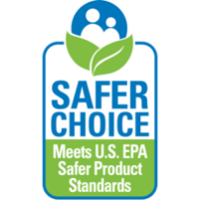
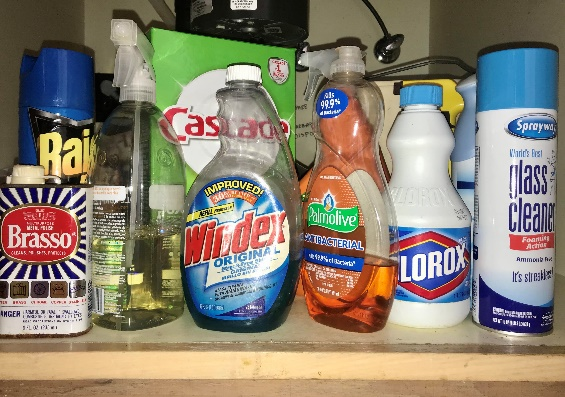
Meeting 8: Continue working on Drug Disposal & Chemicals
- Thank everyone for participating.
- Ask your Action Step leaders to report on the progress with Energy Efficiency, Solid Waste & Recycling, and Education.
- At this meeting, choose one or two Action Steps from “Workbook 5: Drug Disposal & Chemicals”: https://mygreendoctor.org/workbook-5-drug-disposal-chemicals/. We recommend choosing from “Discarding Pharmaceuticals”, “Green Cleaning Supplies”, “Green Hand Soaps”, or “Say ‘NO’ to Mercury”. Each of these is provided below. Find a leader for each Action Step that you choose.
- Announce the date for the next meeting when you will continue with ”Drug Disposal & Chemicals”.
- After the meeting, fill out the Green Meeting Notes form. Keep it very brief– not more than 5 minutes for completing the form: Green Meeting Notes Form . File this and email it to [email protected].
 Drug Disposal & Chemicals Action Steps
Drug Disposal & Chemicals Action Steps
 Discarding Pharmaceuticals
Discarding Pharmaceuticals
Adopt a policy for safe disposal of prescription medications and non-prescription products by your office, your families, and your patients. Prepare a one-page handout for your office and patients. My Green Doctor’s “Education” tab has brochures, handouts, posters, and blogs for you. Every time your office recommends a new medication to patients, remind them how to safely discard their old pharmaceuticals. Print our free posters & buy simple picture frames to inform your colleagues and patients:
https://mygreendoctor.org/education/waiting-room-posters/
Here are some key messages:
- Never discard medicines in the sink or toilet as these can contaminate public water supplies.
- Most medicines, vitamins, and herbal medicines can be thrown into your household or office trash. These include prescription and over-the-counter (OTC) drugs available as pills, liquids, drops, patches, creams, and inhalers.
- Scratch out personal information on the empty packaging to protect privacy.
- If you are concerned that the medicines such as pain medicines could be misused by others, mix them with something undesirable, such as used coffee grounds, dirt, or cat
- litter, before discarding them in the trash.
- Some medicines come with instructions for their disposal. Some inhalers can be dangerous if the container is punctured. You can ask your pharmacist how to dispose of these items safely.
- Medicines can be returned to most pharmacies for disposal.
- Some communities have “Drop Boxes” for collecting medicines safely.
- If you are not sure what is advised in your community, go online or call your pharmacist, local government, your trash collector, or your hazardous waste collection center.
Issues to Consider:
- Can we agree to do this?
- Who will lead this project?
 Green Cleaning Supplies
Green Cleaning Supplies
Adopt an office policy to use only “green chemicals” endorsed by Safer Choice (from the U.S. Environmental Protection Agency), Green Seal, or a similar organization. These products are safer for you and safer for the environment. Products to identify in your office include hand soaps, general cleaners, toilet bowl cleaners, carpet cleaners, glass cleaners, floor strippers, and waxes.
Never use bleach, a common cause of lung injury to health professionals. The company that sells cleaning products to your practice may know about safe chemical options. Consider sharing with your colleagues and patients our “Green Cleaning” blog: https://mygreendoctor.org/green-cleaning-an-easy-guide-for-homes-offices/. Tell your patients that you use safer, “greener” chemicals!
Issues to Consider:
- Can we agree to do this?
- Who will lead this project?
 Green Hand Soaps.
Green Hand Soaps.
Adopt a policy to use only “green” hand cleansers in public areas such as restrooms. Avoid “anti-bacterial” products as they generally are not necessary, are expensive, and can harm the environment.
- Never use soaps containing triclosan, a chemical that is particularly hazardous.
- Consider sharing with your colleagues and patients our blog on choosing hand soaps: https://mygreendoctor.org/safe-soap-cheaper-greener-by-avoiding-triclosan-2/
- Display signs stating that you use only environmentally certified cleaning products for the safety of your patients and the environment.
- Print a My Green Doctor blog on this topic for patients and staff.
Issues to Consider:
- Can we agree to do this?
- Who will lead this project?
 Say “No” to Mercury
Say “No” to Mercury
Adopt a policy to eliminate all mercury from your office. Mercury is a metal used in liquid form in many medical devices, such as sphygmomanometers, thermometers, and thermostats. Mercury, when spilled, will evaporate at room temperature to become a toxic gas that causes nerve damage, kidney disease, and harm to unborn children. Take an inventory of your mercury-containing devices. Plan a timetable to rid the office and your homes of mercury-containing devices. Fluorescent lightbulbs contain mercury; always discard these safely. See our “Workbook 1: Energy Efficiency” for more information on lightbulbs.
Issues to Consider:
- Can we agree to do this?
- Who will lead this project?

Meeting 9: Begin Workbook 7: Healthy Foods
- Thank everyone for participating.
- Ask your leaders to report on the progress with your Action Steps and Education Steps from Meetings 2 through 8.
- At this meeting, choose one or two Action Steps from “Workbook 7: Healthy Foods in the Office: https://mygreendoctor.org/workbook-7-healthy-foods-in-the-office/. We recommend choosing from “Go Meatless”, “Our Healthy Foods Policy”, or “Healthy Eating Poster or Handout”. Each of these is provided below. Find a leader for each Action Step that you choose.
- Announce the date for the next meeting when you will discuss ”Assessment and Moving Forward”.
- After the meeting, fill out the Green Meeting Notes form. Keep it very brief– not more than 5 minutes for completing the form: Green Meeting Notes Form . File this and email it to [email protected].
 Healthy Foods Action Steps
Healthy Foods Action Steps
 Go Meatless
Go Meatless
Adopt a policy for everyone in the office to have no meat in their diets in your office or at home for at least one day each week. It might be “Meatless Wednesday”! The environment and most people benefit from avoiding meat products, and especially fatty meats and meats from 4-legged animals (beef, pork, lamb, mutton & goat). A terrific website on this is offered by the U.S. non-profit group, “Physicians Against Red Meat”: https://www.PhARM.org. Tell your families and patients.
Issues to Consider:
- Can we agree to do this?
- Who will lead this project?
 Our Healthy Foods Policy
Our Healthy Foods Policy
Adopt a policy to have healthy foods in your office: healthy for the staff, for the patients, and for the environment. Here is a list of practical, industry-standard guidelines that you can print and give to pharmaceutical representatives and other vendors who bring foods to the office (our thanks to chef Cathy Collins in Jacksonville, Florida.
Healthy Foods Policy for Healthcare Practices
“Our healthcare office wishes to promote a healthy workplace and to reduce our carbon footprint. Please consider these guidelines in choosing caterers and restaurants for food and beverages that you bring us.”
- Organic: Choose organic foods and beverages.
- Go local: Seek produce & specialty products that come from within 100 miles of our community.
- Be Sustainable: Offer fish and seafood products from sustainable fisheries and farms.
- Healthy fats: Use no trans fats in the preparation of foods for our office.
- Meatless: Offer a meatless lunch option, in addition to salads.
- Recyclable/Reusable: Use recyclable or reusable plates, cups and cutlery.
- Containers: Use recyclable or reusable containers and bags for deliveries.
- Whole foods: Promote healthier eating by using as many whole grains, beans, and fresh and unprocessed foods as possible.
- Healthy cooking: Avoid fried, oily, less healthy foods.
 Display a “Healthy Eating” Poster or Handout
Display a “Healthy Eating” Poster or Handout
Print the free document provided by My Green Doctor titled, “Healthy Eating is Green, Too!” This was designed by Nicole O’Brien of the Orange County Health Department, Orlando, Florida, USA. Your office can print this as a one-page flyer to make available to patients in your waiting room, or you can print it in a larger size to hang in your waiting room or in examination rooms. Your patients and staff will learn about the health and environmental benefits of choosing foods produced from within 100 miles of your community.
 Install a small hydroponic garden growing tower in your office.
Install a small hydroponic garden growing tower in your office.
Adding natural edible plants has many benefits. For example, it allows your office to grow healthy fresh produce like greens and herbs to share with colleagues and patients by using a very small amount of water and small LED lights to grow the plants. It also provides you with an easy icebreaker to start a conversation about healthy eating and the environment with your patients.
Purchase a hydroponic garden here: Tower Garden
Issues to Consider:
- Can we agree to do this?
- Where will we locate our hydroponic garden inside our office?
- Who will lead this Action Step?
Meeting 10: Assessment and Looking Forward
- Thank everyone for participating.
- At this meeting, ask your Action Step leaders to review your progress with each the Steps adopted in Meetings 1-9. Discuss how your practice will continue your work on these topics:
- Energy Efficiency
- Solid Waste & Recycling
- Education
- Drug Disposal & Chemicals
- Healthy Foods in the Office
- If you have not done so already, email your Green Meeting Notes forms, or any records that you have created, to My Green Doctor ([email protected]) and tell us that you have qualified for your Green Practice Recognition Certificate. When you receive it, pring two copies of your Certificate and buy simple frames to display this proudly in your waiting room and staff break room. Post on social media that your office, clinic, or outpatient center has earned the Green Practice Recognition Certificate and describe your journey for the benefit of others.
- Announce the date for the next meeting, continuing to add five minutes of My Green Doctor to your practice’s business or staff meetings.
- After the meeting, fill out the Green Meeting Notes form. Keep it very brief– not more than 5 minutes for completing the form: Green Meeting Notes Form . File this and email it to [email protected].


Meeting-by Meeting: Meeting 11 and Beyond: “The Road Ahead is Green”
“Green” is now part of the culture of your office, clinic, or outpatient center. Congratulations!
Look back at “Ten Reasons to Go Green”, and see if these have been true for you: https://mygreendoctor.org/welcome-to-my-green-doctor/ten-reasons-to-go-green/. My Green Doctor would love to receive a brief email with your impressions, feedback, and suggestions: [email protected].
My Green Doctor hopes you will continue to include five minutes of My Green Doctor as part of every staff meeting of your office, clinic, or outpatient center. My Green Doctor offers more than 140 ideas for how to make your place of work and community healthier. You will never run out of worthwhile, and money-saving Action Steps and Education Steps.
(Photo source: Shutterstock)
At Each Office, Clinic, or Outpatient Center Meeting:
- Thank everyone for participating.
- At each meeting, ask your Action Step leaders to review your progress with the Action Steps and Education Steps that you have adopted.
- At each meeting, try to adopt one new Action Step from the My Green Doctor Workbooks. Remember to include an Education component, such as an announcement for your office colleagues, a newsletter item, a waiting room brochure, a poster, or a “Tip of the Month” for your patients and their families: https://mygreendoctor.org/tip-of-the-month/.
- Here are a few ideas for Action Steps for your practice:
- Energy Efficiency: “Complete an Office Energy Audit”, “Engage Your Office Neighbors”, or “Install Motion Detectors”.
- Renewable Energy: “Buy Renewable Energy”, and create a one-page handout telling your patients how they can also use renewable energy at home.
- Water Efficiency: “Inspect Your Irrigation System” or “Turn Off Your Hot Water Heater”.
- Solid Waste & Recycling: This workbook has 38 ideas that you can use in your practice, most of them are easy!
- Consider using My Green Doctor’s Green
Purchasing Platform to buy products and services for your office that are as safe as possible for those in your office, for the environment, for the climate, and for the people who make the products that you buy: https://mygreendoctor.org/green-purchasing/
- Drug Disposal & Chemicals: “Adopt a Green Chemicals Policy”, “Deploy Insect “Bait Stations” Instead of Chemical Sprays”.
- Transportation & Commuting: “Encourage Bicycle Use”, “Calculate the office Transportation Carbon Footprint’, “Educate Each other on Electric or Low-Emission Vehicles”.
- Healthy Foods for the Office: “Go Meatless”, “Start a Garden”, “Join a Local Food Box”: https://mygreendoctor.org/why-not-join-a-local-food-box-or-csa/.





